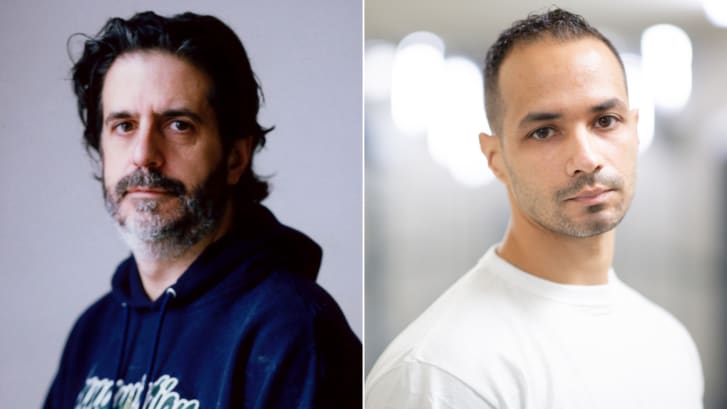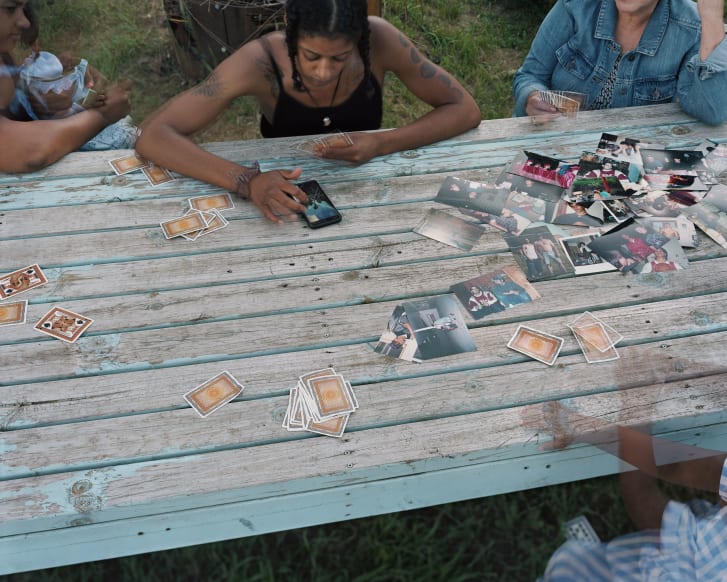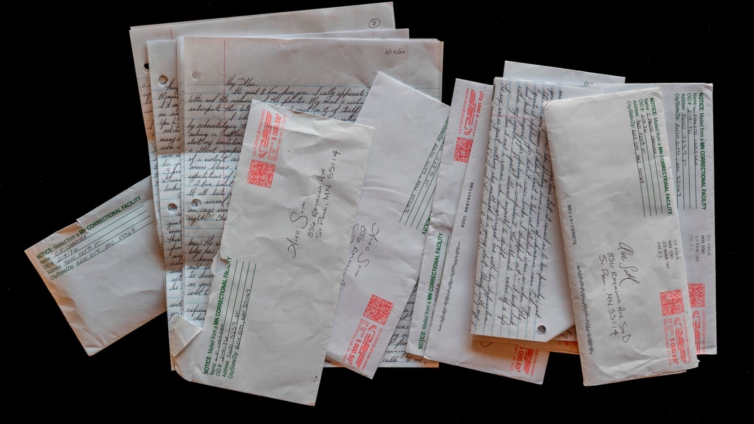This past January, photographer Alec Soth received a letter in the mail at his studio in St. Paul, sent from the Minnesota Correctional Facility just north of him in Rush City.
It was from an inmate and self-taught artist, Christopher Fausto Cabrera, asking to start a dialogue.
"Please forgive the audacity of this letter. I reach out in great admiration and respect," wrote Cabrera. He said he was reaching out to local artists, hoping to connect.
"By no way am I absolved of my past -- but I seek to pay something forward through my art and writing..."Intrigued, Soth replied, forming the first link in a chain that would bond the two men.

Nearly a year later, Cabrera's initial outreach has turned into innumerable letters, emails and phone calls, set against the backdrop of tumultuous world events, from the coronavirus pandemic taking root in the US to the Black Lives Matter protests that took place throughout the country following the killing of George Floyd in Minneapolis.
A portion of their conversations has been published in a recent book, "The Parameters of Our Cage" published by Mack.
"The physical nature of a letter in the mail is touching, just because there's so little of that," Soth said during a video interview.
He is a photographer who works primarily with tactile media, shooting 8x10 film and publishing photography books that attempt to gaze into the interior lives of his subjects. Cabrera, meanwhile, has cultivated his own creative side while in prison.

In their letters, Soth and Cabrera grapple with complex topics that reflect larger undercurrents running within the country: the inequity of the criminal justice system, the effects of isolation, how polarization sows discord between people.
They confide deep personal truths and discuss photography and art through a critical lens. And though their friendship may be unexpected due to the physical limitations inherent to it, Cabrera doesn't necessarily find it any different from a friendship that could blossom under more ordinary circumstances.
"We meet people all the time that change our trajectories with their presence due to this 'otherworldly' bond that seems to develop on its own," he wrote to CNN over JPay, a corrections service that includes email.
A surprising bond
Cabrera first reached out to Soth to expand his creative community beyond what he had carved out for himself while in prison.
Following his convictions of second-degree murder and first-degree attempted murder for committing a drive-by shooting in 2004, he spent over a decade at another correctional facility in Stillwater (Cabrera is due for release in 2030).
He had worked in the art department there, teaching and "developing a path for future students to follow," he said."There is a function to art in here: tattooing, portraits of kids and family members, memorial pieces and even original greeting cards can quickly establish a reputation for you as an artist," Cabrera said.
"But I still wouldn't have identified as an artist; it was just something I did. Our identities are seeped in negativity here, not only because of the condemnation of the conviction but because of how the system is set up to maintain and perpetuate a certain stigma."

After having his art published on the cover of the Washington Post Magazine -- an illustration of his younger self holding his mugshot for a special issue on incarceration -- Cabrera felt "a different level of validation," he explained.
"This was a major impetus in reaching out to Alec."Soth was curious about Cabrera's perspective on photography, and in one of their first exchanges, he asked Cabrera to choose only eight images he would bring if he were stranded on a desert island.
Cabrera described them in intricate detail, some real, some imaginary: a real portrait of his mother laughing, just before she became too ill from cancer; an imaginary photo of his aunt and uncle's farm in the summer, with their family present.
Cabrera's aunt and uncle raised him after his mother died, and he was incarcerated before he could see the work they put into their new land.Cabrera also described an imagined image of singer Demi Lovato in her room, writing a song among all of her ephemera. Two of her songs had stayed with him for their sense of solitude.
In response, Soth decided to hold an Instagram contest to bring the image to life, asking followers to make a composite based on his description. In his next letter to Cabrera, he included five finalists out of 40 submissions."Man, the Demi challenge is awesome," Cabrera wrote back.
"I am honored and so impressed by the extent of your effort to make my words tangible. There is a certain magic of possibility in this gesture."Early on, Cabrera sensed that Soth struggled with depression and felt a kinship between them.
Despite coming from two disparate backgrounds, and being in two very different places in life, they were simply two people who saw one another.

"I don't have a lot of friends, so it's just been really valuable to have (this)," Soth said.
"And it's the most unexpected form of friendship."After months of correspondence, Soth said he would be "prone to forget" that Cabrera has a criminal background. But Cabrera reminds him and doesn't evade responsibility for his actions."I know him only in the version of himself that he is now," Soth said.
"I'm much more aware of his incarceration than (of) his crime. But he doesn't let me forget about the crime.""I now take on the responsibility of owning my past fully," Cabrera wrote to Soth in one letter.
"I know that my incarceration in and of itself has done little to solve any of the issues of crime, but it has molded me into the person I should have been all along."
Responding to restrictions
Soth and Cabrera often return to the idea of restrictions and how they can influence creativity and connection. Restrictions abound in their lives and their relationship, from Cabrera's incarceration, to the new reality of the pandemic, to the very limitations that shape their friendship.
(Soth once had a photograph intercepted because guards interpreted something in the image as a gang sign; another time, he said, a letter was returned to him a month later because he included 21 sheets of paper instead of 20.)
The title of the book is drawn from this recurring theme. In a letter, Cabrera recounts to Soth about the time when he was transferred to the Rush City facility from Stillwater -- his allowable personal inventory was reduced to a 2-foot locker.
The library of books and DVDs he had amassed for his art classes at Stillwater were gone; so were many of the art and photography clippings he had spent years collecting.
Yet under the new stringent rules at Rush City, Cabrera saw improvements in his creative practice.

"It all boils down to limits, huh?" he wrote. "Whether enforced by nature -- biologic(al) or social, tangible or abstract, we all confront the parameters of our cage eventually.
What we do when we reach those bars helps define us."During the pandemic, much of the world has had to confront those parameters. "I'm no stranger to having to adapt to an adverse environment. It's a culture shock to most of the rest of the world..." said Cabrera (to CNN) over JPay.
"The pandemic has exposed our character and circumstances on an unprecedented level ... adversarial mentalities can be the strongest bonding adhesive across cultural divides, yet we are turning on each other.
But Cabrera hopes "The Parameter of Our Cage" can show a meaningful connection formed under constraints, and during a time of deep polarity."These are trying times for everyone, for different reasons," Cabrera said.
"This project can do something to build and galvanize an expanded sense of community as we move forward towards a place with a newfound love (and) respect for 'other' people. That isn't limited to inmates. Anyone we consider an 'other' threatens our understanding of 'self.'"
Though the book has been published, the project is indefinite as Soth and Cabrera continue to send letters to one another.
But Soth found a fitting end to "The Parameters of Our Cage."He drove to the farm owned by Cabrera's aunt and uncle, which Cabrera had described in detail as one of the eight images he would take with him to an island.
He had only intended to pick up a few photographs of Cabrera, but while he was there, he recalled a conversation the two had about poker, and photographs that he could take began to take shape in his mind.
"And somehow it all popped into my head," Soth said. "Wouldn't it be great to be out there and have this dreamscape of a poker game?"

Soth returned and photographed Cabrera's extended family by a pond, the sunlight glittering on the water.
They sit at a picnic table, with playing cards while photographs of Cabrera are strewn around the table. Though Cabrera isn't physically there, his presence is etched into the scene -- as is Soth's.
It recalls an early discussion the pair had, when Cabrera said while studying landscape images, he had a realization about photography."It dawned on me one day that photos without people captured the solitude of a single viewer; that there is always someone 'in' the picture," he wrote to Soth.
Cabrera is present in the pictures on the table, through the memories of his family, and through the connection they share with Soth. He was there in other ways, too: "The whole thing was like a dream, because he called his aunt while I was photographing," said Soth.
"And I was there and his family was sad, but (it was) beautiful. And it was a perfect end to the book."
Latest Stories
-
Man remanded for uploading nude videos of a lady he lured into a relationship
3 hours -
Explainer: What is the Cash Waterfall Mechanism?
3 hours -
Survivors of child trafficking overcome adversity, excel in tertiary education
4 hours -
Confront the barriers to your progress – Professor Lydia Aziato challenges the youth
4 hours -
Expertise France leads EU-funded initiative empowering African Journalists to combat human trafficking
4 hours -
Ghana Grows Programme empowers Ghanaian youth through Youth Policy Dialogue
4 hours -
Eastern NDC raises GHS5.4m to support Mahama’s 2024 campaign
5 hours -
Kumawood actress Akyere Bruwaa condemns death rumours
5 hours -
Ghana Institution of Engineering calls for proactive measures to prevent flood disaster
5 hours -
Who pays for the extra cost? – COCOBOD CEO questions EU on new regulations
5 hours -
‘Dumsor’ will be over by end of May – Former NPP MP assures
5 hours -
Power crisis is not about money – NPP Manifesto Committee member
5 hours -
Education Minister urges graduates to embrace opportunities
5 hours -
UN rights chief ‘horrified’ by mass grave reports at Gaza hospitals
6 hours -
We need more resources to deal with flooding – NADMO
6 hours

